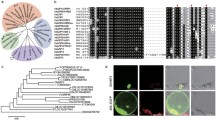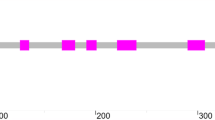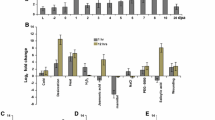Abstract
Key message
The transcription of GhAG2 was strongly enhanced by glyphosate treatment. Overexpression of GhAG2 could improve plant tolerance to salt and salicylic acid stress.
Although glyphosate has been widely used as an herbicide over the past decade owing to its high efficacy on weed controls and worldwide commercialization of glyphosate-resistant crops, little is known about the glyphosate-induced responses and transcriptional changes in cotton plants. Here, we report the identification of 26 differentially expressed genes after glyphosate treatment, among which, six highly up-regulated sequences share homology to cotton expressed sequence tags (ESTs) responsive to abiotic stresses. In addition, we cloned GhAG2, a gene whose transcription was strongly enhanced by glyphosate treatment and other abiotic stresses. Transgenic GhAG2 plants showed improved tolerance to salt, and salicylic acid (SA) stress. The results could open the door to exploring the function of the GhAG2 proteins, the glyphosate-induced transcriptional profiles, and the physiological biochemical responses in cotton and other crops. GhAG2 could also be used to improve salt stress tolerance through breeding and biotechnology in crops. Furthermore, these results could provide guidelines to develop a glyphosate-inducible system for controlled expression of targeted genes in plants.





Similar content being viewed by others
References
Ahsan N, Lee DG, Lee KW, Alam I, Lee SH, Bahk JD, Lee BH (2008) Glyphosate-induced oxidative stress in rice leaves revealed by proteomic approach. Plant Physiol Biochem 46:1062–1070
Arnold K, Bordoli L, Kopp J, Schwede T (2006) The SWISS-MODEL workspace: a web-based environment for protein structure homology modeling. Bioinformatics 22:195–201
Athanasiadis A, Anderluh G, Maček P, Turk D (2001) Crystal structure of the soluble form of equinatoxin II, a pore-forming toxin from the sea anemone Actinia equina. Structure 9:341–346
Baek Y, Bobadilla LK, Giacomini DA, Montgomery JS, Murphy BP, Tranel PJ (2021) Evolution of glyphosate-resistant weeds. Rev Env Contam Toxicol PMI. https://doi.org/10.1007/398_2020_55
Baena-Gonzalez E (2010) Energy Signaling in the regulation of gene expression during stress. Mol Plant 3:300–313
Bauer D, Muller H, Reich J, Riedel H, Ahrenkiel V, Warthoe P, Strauss M (1993) Identification of differentially expressed mRNA species by an improved display technique (DDRT-PCR). Nucleic Acids Res 21:4272–4280
Bell AA (1981) Biochemical-mechanisms of disease resistance. Ann Rev Plant Physiol 32:21–81
Brookes G, Taheripour F, Tyner WE (2017) The contribution of glyphosate to agriculture and potential impact of restrictions on use at the global level. GM Crops Food 8:216–228
Campo S, Peris-Peris C, Montesinos L, Penas G, Messeguer J, Segundo BS (2012) Expression of the maize ZmGF14-6 gene in rice confers tolerance to drought stress while enhancing susceptibility to pathogen infection. J Exp Bot 63:983–999
Cebeci O, Budak H (2009) Global expression patterns of three Festuca species exposed to different doses of glyphosate using the affymetrix genechip wheat genome array. Comp Funct Genom. https://doi.org/10.1155/2009/505701
Chen DY, Chen QY, Wang DD, Mu YP, Wang MY, Huang JR, Mao YB (2020) Differential transcription and alternative splicing in cotton underly specialized defense responses against pests. Front Plant Sci 11:573131
Cuhra M, Traavik T, Bohn T (2013) Clone- and age-dependent toxicity of a glyphosate commercial formulation and its active ingredient in Daphnia magna. Ecotoxicology 22:251–262
Culpepper AS, Webster TM, Sosnoskie LM, York AC (2010) Glyphosate‐resistant palmer amaranth in the United States. Glyphosate resist crops weeds: History, Development, and Management. Hoboken, NJ: John Wiley & Sons, pp 195–212
de Freitas-Silva L, Rodríguez-Ruiz M, Houmani H, da Silva LC, Palma JM, Corpas FJ (2017) Glyphosate-induced oxidative stress in Arabidopsis thaliana affecting peroxisomal metabolism and triggers activity in the oxidative phase of the pentose phosphate pathway (OxPPP) involved in NADPH generation. J Plant Physiol 218:196–205
Délye C (2013) Unravelling the genetic bases of non-target-site-based resistance (NTSR) to herbicides: a major challenge for weed science in the forthcoming decade. Pest Manag Sci 69:176–187
Denkovskiene E, Paskevicius S, Werner S, Gleba Y, Razanskiene A (2015) Inducible expression of Agrobacterium Virulence gene VirE2 for stringent regulation of T-DNA transfer in plant transient expression systems. Mol Plant Microbe Interact 28:1247–1255
Duke SO, Powles SB (2008) Glyphosate: a once-in-a-century herbicide. Pest Manag Sci 64:319–325
Evrard E, Devaux A, Bony S, Burgeot T, Riso R, Budzinski H, Le Du M, Quiniou L, Laroche J (2010) Responses of the European flounder Platichthys flesus to the chemical stress in estuaries: load of contaminants, gene expression, cellular impact and growth rate. Biomarkers 15:111–127
Faus I, Zabalza A, Santiago J, Nebauer SG, Royuela M, Serrano R, Gadea J (2015) Protein kinase GCN2 mediates responses to glyphosate in Arabidopsis. BMC Plant Biol 15:14
Fernández-Moreno PT, Bastida F, De Prado R (2017) Evidence, mechanism and alternative chemical seedbank-level control of glyphosate resistance of a rigid Ryegrass (Lolium rigidum) biotype from southern Spain. Front Plant Sci 8:450
Gaines TA, Zhang WL, Wang DF, Bukun B, Chisholm ST, Shaner DL, Nissen SJ, Patzoldt WL, Tranel P, Culpepper AS, Grey TL, Webster TM, Vencill WK, Sammons RD, Jiang J, Preston C, Leach JE, Westra P (2010) Gene amplification confers glyphosate resistance in Amaranthus palmeri. Proc Natl Acad Sci USA 107:1029–1034
Gao S, Ma W, Lyu X, Cao X, Yao Y (2020) Melatonin may increase disease resistance and flavonoid biosynthesis through effects on DNA methylation and gene expression in grape berries. BMC Plant Biol 20:231
García-Ruiz EÍ, Loureiro Farinós GP, Gómez P, Gutiérrez E, Sánchez FJ, Escorial MC, Ortego F, Chueca MC, Castañera P (2018) Weeds and ground-dwelling predators’ response to two different weed management systems in glyphosate-tolerant cotton: a farm-scale study. PLoS ONE 13:e0191408. https://doi.org/10.1371/journal.pone.0191408
Gomes MP, Le Manac’h SG, Moingt M, Smedbol E, Paquet S, Labrecque M, Lucotte M, Juneau P (2016a) Differential effects of glyphosate and aminomethylphosphonic acid (AMPA) on photosynthesis and chlorophyll metabolism in willow plants. Pestic Biochem Physiol 130:65–70
Gomes MP, Le Manac’h SG, Moingt M, Smedbol E, Paquet S, Labrecque M, Lucotte M, Juneau P (2016b) Impact of phosphate on glyphosate uptake and toxicity in willow. J Hazard Mater 304:269–279
Gong Z, Shen W, Zhou G, Huang J, Qian S (1988) Technique of transformation exogenous DNA into plant after pollination-DNA fragments were transferred into embryos via pollen tube. Sci China (b) 6:611–614
Gunjegaonkar SM, Shanmugarajan TS (2019) Molecular mechanism of plant stress hormone methyl jasmonate for its anti-inflammatory activity. Plant Signal Behav 14:e1642038
Hara M, Furukawa J, Sato A, Mizoguchi T, Miura K (2012) Abiotic stress and role of salicylic acid in plants. In: Ahmad P, Prasad M (eds) Abiotic stress responses in plants. Springer, New York, NY. https://doi.org/10.1007/978-1-4614-0634-1_13
Hattori Y, Nagai K, Furukawa S, Song XJ, Kawano R, Sakakibara H, Wu J, Matsumoto T, Yoshimura A, Kitano H, Matsuoka M, Mori H, Asshikari M (2009) The ethylene response factors SNORKEL1 and SNORKEL2 allow rice to adapt to deep water. Nature 460:1026–1030
He X, Zeng J, Cao F, Ahmed IM, Zhang G, Vincze E, Wu F (2015) HvEXPB7, a novel β-expansin gene revealed by the root hair transcriptome of Tibetan wild barley, improves root hair growth under drought stress. J Exp Bot 66:7405–7419. https://doi.org/10.1093/jxb/erv436
Karn E, Jasieniuk M (2017) Genetic diversity and structure of Lolium perenne ssp. multiflorum in California vineyards and orchards indicate potential for spread of herbicide resistance via gene flow. Evol Appl 10:616–629
Kelley KB, Lambert KN, Hager AG, Riechers DE (2004) Quantitative expression analysis of GH3, a gene induced by plant growth regulator herbicides in soybean. J Agric Food Chem 52:474–478
Kelliher T, Walbot V (2014) Maize germinal cell initials accommodate hypoxia and precociously express meiotic genes. Plant J 77:639–652
Khan MIR, Fatma M, Per TS, Anjum NA, Khan NA (2015) Salicylic acid-induced abiotic stress tolerance and underlying mechanisms in plants. Front Plant Sci 6:462
Kondera E, Teodorczuk B, Ługowska K, Witeska M (2018) Effect of glyphosate-based herbicide on hematological and hemopoietic parameters in commoncarp (Cyprinus carpio L). Fish Physiol Biochem 44:1011–1018
Liang P, Pardee AB (1992) Differential display of eukaryotic messenger RNA by means of the polymerase chain reaction. Science 257:967–971
Liu B, Wang X, Li K, Cai Z (2021) Spatially resolved metabolomics and lipidomics reveal salinity and drought-tolerant mechanisms of cottonseeds. J Agric Food Chem 69:8028–8037
Loreti E, Perata P (2020) The many facets of hypoxia in plants. Plants (basel) 9:745
Lu W, Li L, Chen M, Zhou ZF, Zhang W, Ping SZ, Yan YL, Wang J, Lin M (2013) Genome-wide transcriptional responses of Escherichia coli to glyphosate, a potent inhibitor of the shikimate pathway enzyme 5-enolpyruvylshikimate-3-phosphate synthase. Mol Biosyst 9:522–530
Mellway RD, Tran LT, Prouse MB, Campbell MM, Constabel CP (2009) The wound-, pathogen-, and ultraviolet B-responsive MYB134 gene encodes an R2R3 MYB transcription factor that regulates proanthocyanidin synthesis in poplar. Plant Physiol 150:924–941
Michoux F, Takasaka K, Boehm M, Nixon PJ, Murray JW (2010) Structure of CyanoP at 2.8 Å: implications for the evolution and function of the PsbP subunit of photosystem II. Biochemistry 49:7411–7413
Miura K, Tada Y (2014) Regulation of water, salinity, and cold stress responses by salicylic acid. Front Plant Sci 5:4
Munns R, Tester M (2008) Mechanisms of salinity tolerance. Annu Rev Plant Biol 59:651–681
Olvera-Carrillo Y, Campos F, Reyes JL, Garciarrubio A, Covarrubias AA (2010) Functional analysis of the group 4 late embryogenesis abundant proteins reveals their relevance in the adaptive response during water deficit in Arabidopsis. Plant Physiol 154:373–390
Perez A, Kogan M (2003) Glyphosate-resistant Lolium multiflorum in chilean orchards. Weed Res 43:12–19
Pline WA, Wilcut JW, Duke SO, Edmisten KL, Wells R (2002) Tolerance and accumulation of shikimic acid in response to glyphosate applications in glyphosate-resistant and nonglyphosate-resistant cotton (Gossypium hirsutum L.). J Agric Food Chem 50:506–512
Pline WA, Wells R, Little G, Edmisten KL, Wilcut JW (2003) Glyphosate and water-stress effects on fruiting and carbohydrates in glyphosate-resistant cotton. Crop Sci 43:879–885
Rabbani MA, Maruyama K, Abe H, Khan MA, Katsura K, Ito Y, Yoshiwara K, Seki M, Shinozaki K, Yamaguchi-Shinozaki K (2003) Monitoring expression profiles of rice genes under cold, drought, and high-salinity stresses and abscisic acid application using cDNA microarray and RNA gel-blot analyses. Plant Physiol 133:1755–1767
Saitou N, Nei M (1987) The Neighbor-Joining method - a new method for reconstructing phylogenetic trees. Mol Biol Evol 4:406–425
Sammons RD, Gaines TA (2014) Glyphosate resistance: state of knowledge. Pest Manag Sci 70:1367–1377
Schwede T, Kopp J, Guex N, Peitsch MC (2003) SWISS-MODEL: an automated protein homology-modeling server. Nucleic Acids Res 31:3381–3385
Seki M, Narusaka M, Abe H, Kasuga M, Yamaguchi-Shinozaki K, Carninci P, Hayashizaki Y, Shinozaki K (2001) Monitoring the expression pattern of 1300 Arabidopsis genes under drought and cold stresses by using a full-length cDNA microarray. Plant Cell 13:61–72
Seki M, Narusaka M, Ishida J, Nanjo T, Fujita M, Oono Y, Kamiya A, Nakajima M, Enju A, Sakurai T (2002) Monitoring the expression profiles of 7000 Arabidopsis genes under drought, cold and high-salinity stresses using a full-length cDNA microarray. Plant J 31:279–292
Sergiev IG, Alexieva VS, Ivanov SV, Moskova II, Karanov EN (2006) The phenylurea cytokinin 4PU-30 protects maize plants against glyphosate action. Pestic Biochem Physiol 85:139–146
Sham A, Moustafa K, Al-Ameri S, Al-Azzawi A, Iratni R, AbuQamar S (2015) Identification of Arabidopsis candidate genes in response to biotic and abiotic stresses using comparative microarrays. PLoS ONE 10:e0125666
Siehl DL, Roe RM (1997) Inhibitors of EPSP synthase, glutamine synthetase and histidine synthesis. Rev Toxicol 1:37–67
Soares C, Pereira R, Spormann S, Fidalgo F (2019) Is soil contamination by a glyphosate commercial formulation truly harmless to non-target plants?—Evaluation of oxidative damage and antioxidant responses in tomato. Env Pollut 247:256–265
Spormann S, Soares C, Fidalgo F (2019) Salicylic acid alleviates glyphosate-induced oxidative stress in Hordeum vulgare L. J Env Manag 241:226–234
Stavridou E, Voulgari G, Michailidis M, Kostas S, Chronopoulou EG, Labrou NE, Madesis P, Nianiou-Obeidat I (2021) Overexpression of a biotic stress-inducible pvgstu gene activates early protective responses in tobacco under combined heat and drought. Int J Mol Sci 22:2352
Stevens MT, Lindroth RL (2005) Induced resistance in the indeterminate growth of aspen (Populus tremuloides). Oecologia 145:298–306
Tamura K, Dudley J, Nei M, Kumar S (2007) MEGA4: molecular evolutionary genetics analysis (MEGA) software version 4.0. Mol Biol Evol 24:1596–1599
Thompson JD, Gibson TJ, Plewniak F, Jeanmougin F, Higgins DG (1997) The CLUSTAL_X windows interface: flexible strategies for multiple sequence alignment aided by quality analysis tools. Nucleic Acids Res 25:4876–4882
Sakhanokho HF, Rajasekaran K (2016) Cotton regeneration in vitro. In: Ramawat K, Ahuja M (eds) Fiber Plants. Sustainable development and biodiversity, 13: 87–110. Springer, Cham. https://doi.org/10.1007/978-3-319-44570-0_6
Vicente MRS, Plasencia J (2011) Salicylic acid beyond defence: its role in plant growth and development. J Exp Bot 62:3321–3338
Vlad D, Abu-Jamous B, Wang P, Langdale JA (2019) A modular steroid-inducible gene expression system for use in rice. BMC Plant Biol 19:426
Wang M, Zhang B, Wang Q (2013) Cotton transformation via pollen tube pathway. In: Zhang B (ed) Transgenic cotton methods in molecular biology (Methods and Protocols), vol 958. Humana Press, Totowa, NJ. https://doi.org/10.1007/978-1-62703-212-4_6
Wang C, Lin X, Li L, Lin SJ (2016) Differential growth responses of marine phytoplankton to herbicide glyphosate. PLoS ONE 11:e0151633. https://doi.org/10.1371/journal.pone.0151633
Webster TMU, Santos EM (2015) Global transcriptomic profiling demonstrates induction of oxidative stress and of compensatory cellular stress responses in brown trout exposed to glyphosate and roundup. BMC Genom 16:32
Webster TM, Everest AMPJ, Brecke FJFB, Martin KJGJ, Kelly LEWS, Griffin J, Sanders D, Byrd MJ, Kendig MA, Fisher L (2009) Weed survey-Southern states, 2009: Broadleaf crops subsection (cotton, peanut, soybean, tobacco, and forestry). Proc South Weed Sci Soc 54:244–259
Williams S, Friedrich L, Dincher S, Carozzi N, Kessmann H, Ward E, Rylas J (1992) Chemical regulation of Bacillus thuringiensis∂-endotoxin expression in transgenic plants. Nature Biotech 10:540–543
Woodburn AT (2000) Glyphosate: production, pricing and use worldwide. Pest Manag Sci 56:309–312
Yasuor H, Abu-Abied M, Belausov E, Madmony A, Sadot E, Riov J, Rubin B (2006) Glyphosate-induced anther indehiscence in cotton is partially temperature dependent and involves cytoskeleton and secondary wall modifications and auxin accumulation. Plant Physiol 141:1306–1315
Yu WC, Zhang R, Guo SD (2005) Isolation of glyphosate-induced EST sequences of soybean and cotton. Prog Biotech 25:80–85
Yu WC, Zhang R, Li RZ, Guo SD (2007) Isolation and characterization of glyphosate-regulated genes in soybean seedlings. Plant Sci 172:497–504
Zeng H, Xu H, Liu G, Wei Y, Zhang J, Shi H (2021) Physiological and metagenomic strategies uncover the rhizosphere bacterial microbiome succession underlying three common environmental stresses in cassava. J Hazard Mater 411:125143
Zhang GY, Chen M, Chen XP, Xu ZS, Guan S, Li LC, Li AL, Guo JM, Mao L, Ma YZ (2008) Phylogeny, gene structures, and expression patterns of the ERF gene family in soybean (Glycine max L.). J Exp Bot 59:4095–4107
Zhang JT, Liu H, Sun J, Li B, Zhu Q, Chen SL, Zhang HX (2012) Arabidopsis fatty acid desaturase FAD2 is required for salt tolerance during seed germination and early seedling growth. PLoS ONE 7:e30355. https://doi.org/10.1371/journal.pone.0030355
Zhao JM, Williams CC, Last RL (1998) Induction of Arabidopsis tryptophan pathway enzymes and camalexin by amino acid starvation, oxidative stress, and an abiotic elicitor. Plant Cell 10:359–370
Zheng M, Lin J, Liu X, Chu W, Li J, Gao Y, An K, Song W, Xin M, Yao Y, Peng H, Ni Z, Sun Q, Hu Z (2021) Histone acetyltransferase TaHAG1 acts as a crucial regulator to strengthen salt tolerance of hexaploid wheat. Plant Physiol 186:1951–1969. https://doi.org/10.1093/plphys/kiab187
Zhong Z, Furuya T, Ueno K, Yamaguchi H, Hitachi K, Tsuchida K, Tani M, Tian J, Komatsu S (2020) Proteomic analysis of irradiation with millimeter waves on soybean growth under flooding conditions. Int J Mol Sci 21:486. https://doi.org/10.3390/ijms21020486
Zhu JK (2016) Abiotic stress signaling and responses in plants. Cell 167:313–324
Zhu J, Patzoldt WL, Shealy RT, Vodkin LO, Clough SJ, Tranel PJ (2008) Transcriptome response to glyphosate in sensitive and resistant soybean. J Agric Food Chem 56:6355–6363
Funding
This work was supported by the National Natural Science Foundation of China (31201245, 31571825, 31771850).
Author information
Authors and Affiliations
Contributions
WY, RZ, and SG conceived and designed the research plans. WY and ZX performed most of the experiments. XZ provided technical assistance to WY. WY and JL analyzed the data and wrote the article with contributions of all the authors. All authors read and approved the manuscript.
Corresponding authors
Ethics declarations
Conflict of interest
The authors declare that they have no competing interests.
Additional information
Communicated by Andrew Leigh Eamens.
Publisher's Note
Springer Nature remains neutral with regard to jurisdictional claims in published maps and institutional affiliations.
Supplementary Information
Below is the link to the electronic supplementary material.
Rights and permissions
About this article
Cite this article
Yu, W., Xue, Z., Zhao, X. et al. Glyphosate-induced GhAG2 is involved in resistance to salt stress in cotton. Plant Cell Rep 41, 1131–1145 (2022). https://doi.org/10.1007/s00299-022-02844-3
Received:
Accepted:
Published:
Issue Date:
DOI: https://doi.org/10.1007/s00299-022-02844-3




